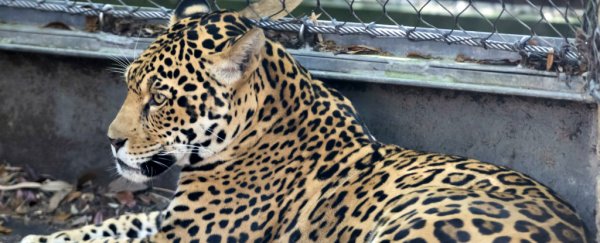A jaguar at the Audubon Zoo in New Orleans slipped out of its enclosure and went on a territorial killing rampage sometime overnight, attacking four alpacas, an emu and a fox trapped in their own habitats before zoo officials managed to sedate it.
The big cat was first reported missing at 7:20 am, before the zoo opened, officials said in a press release. By 8:15 it had been spotted, tranquilized and returned to its enclosure by veterinarians.
No humans were injured by the animal, although the circumstances of the escape sparked a worrisome thought at what might have been: The "jaguar jungle" is also home to a children's play area.
In a news conference Saturday, zoo officials insisted the facility was safe for the general public, even though they wouldn't say how the apex predator managed to escape and either kill or injure every alpaca on zoo property.
In addition to the slain animals, three other injured animals were being cared for.
The jaguar, a 3-year-old named Valerio, did not appear to be eating the animals it went after, but rather was engaged in a territorial display, said Kyle Burks, the zoo's vice president and managing director. The animals it pounced on were unable to escape their own enclosures.
The zoo was closed Saturday as officials tried to discover how the feline escaped. Grief counselors were also brought in for traumatized staff. The zoo planned to reopen Sunday at 10 am.
But the incident was certain to raise questions about the dangers of caging apex predators that have evolved to hunt and kill, and will quickly pounce on prey animals — or humans — if safeguards break down.
In the Spring of 2017, a British zookeeper was mauled after being trapped in the Hamerton Park Zoo's tiger enclosure with at least one of the big cats.
Horrified witnesses said they could see zookeepers sprinting to the edge of the tiger enclosure, throwing pieces of meat as an unsuccessful distraction.
In 2016, 38-year-old zookeeper Stacey Konwiser was killed by a tiger while preparing the "night house" at the Palm Beach Zoo. The house is where the animals are cleaned and fed, then boarded overnight.
Also that year, at Beijing Safari World, a woman was injured and her mother killed after the younger woman got out of their car and was dragged off by a tiger.
Such breakdowns, experts have told The Post, don't merely happen at shoddy zoos with slapdash animal-care practices.
"These accidents happen, you know, on some kind of a recurring basis around the world," said Doug Cress, chief executive of the World Association of Zoos and Aquariums.
"And it's because you're dealing with animals that, at their genetic core, are built differently than we might like them to be. They are designed to be wild animals."
Joel Hamilton, the Audubon Zoo's vice president and animal curator, echoed that sentiment when asked whether there was something particularly aggressive about Valerio.
"He's a young male jaguar," said Joel Hamilton, the zoo's vice president and general curator. "He was doing what jaguars do. Certainly his behavior wasn't out of the ordinary for that kind of an animal."
Jaguars are opportunistic hunters that prey on more than 85 species, according to the International Union for Conservation of Nature.
Their habitat ranges from the jungles of Central and South America, where they are considered "near threatened" by IUCN, to the southern regions of Arizona and New Mexico, where they are listed as an endangered species by the U.S. Fish and Wildlife Service.
Lions and tigers are the only big cats that are bigger than jaguars, making the felines the biggest in the Americas.
The Audubon Zoo, which originated from a bird habitat built in 1916, is a "58-acre jewel ranking among the nation's best zoos," according to the Audubon Nature Institute, which oversees the zoo and other properties. It is situated in Uptown New Orleans, between Audubon Park and the Mississippi River.
Ron Forman, the president and chief executive of the zoo, said Saturday's series of attacks was the worst in the zoo's history, but told the public the Audubon Zoo was still safe.
"The zoo, it's been here for 100 years," Forman said. In that time period, we've had over 100 million visitors to the zoo. We've never had an incident like that before. So I think statistically there's nothing to worry about the safety of coming to the zoo."
2018 © The Washington Post
This article was originally published by The Washington Post.
